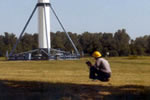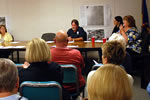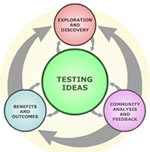What is Science?
You have just listed the ways in which your process for solving the numbers puzzle was similar to what scientists do when they are solving scientific problems. Do you think your list reflects any of key features of science? Let's take a look!
This checklist describes the usual features of science. Some of these characteristics are really important to all scientific studies, while others may not be involved in every scientific endeavor. Overall, though, scientific work can be distinguished by including the majority of these characteristics. Think back to the numbers puzzle. Click on each characteristic to see if you did this while solving the numbers puzzle.
Click the image to open the interactive activity.
Text Version
 Is That Science?
Is That Science?
Now that you have a checklist that describes the characteristics of science, let's see if you can determine whether each of the questions in this game can be addressed through science or not. Use your checklist if you need to. Click the image to open the interactive activity.
Text Version
A Scientific Recipe?
You've probably nearly memorized the standard scientific method – that nice, neat linear progression of five steps: Observe, Hypothesize, Experiment, Analyze, and Conclude. But is all science really like that? Can you always use the same linear recipe to produce scientific results?
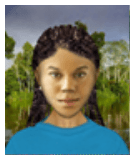
Text Version
Science is influenced by society and influences society in many ways. The benefits and outcomes of science include introducing new technologies, influencing policy, building general knowledge, and simply satisfying curiosity.
The Process of Science
Science is a body of knowledge and a process through which we discover and explain the natural world. Although we've learned that not all science progresses through the exact same series of steps, there are general processes that are characteristic of all scientific endeavors. Can you figure out what these major processes are, by looking at the pictures below?
Click each picture below.
- apes_puttingbladestogetherforturbine_431x580
Exploration and Discovery – All scientific studies begin with a period of exploration and discovery. Sometimes this involves serendipity, sometimes targeted observations, and sometimes just accidents or chance. Eventually though an interesting question is formed, and that calls for a search for the answer.
- apes_testingmodelwindturbine_300x389
Testing Ideas – To answer a scientific question, you must develop a hypothesis that helps you design a test and then gather and interpret the resulting data to determine where to go next.
- apes_communitymeeting_580x389
Community Analysis and Feedback – In order to come to a strong conclusion, it's necessary for scientists to share and discuss the interpretations of their data.
- apes_windturbines_580x386
Exploration and Discovery – All scientific studies begin with a period of exploration and discovery. Sometimes this involves serendipity, sometimes targeted observations, and sometimes just accidents or chance. Eventually though an interesting question is formed, and that calls for a search for the answer.
putting blades together for wind turbine
Testing Ideas – To answer a scientific question, you must develop a hypothesis that helps you design a test and then gather and interpret the resulting data to determine where to go next.
testing model of wind turbine
Community Analysis and Feedback – In order to come to a strong conclusion, it's necessary for scientists to share and discuss the interpretations of their data.
Community meeting
Benefits and Outcomes – Once a conclusion has been reached, scientific studies can be used to develop new technologies, inform public policy, or just contribute generally to our knowledge base.
Science most often progresses through these four processes in this order, but not always! Sometimes surprises, errors, or new knowledge requires going back to refine a study or develop a different question.
Take a look at the Understanding Science flowchart by cliking the Examine link below. Moving your mouse over the flow chart will allow you to see more details about each category.
Click the image below.
Hypotheses, Theories, and Laws
Scientific explanations come at many different levels.
Click on each term below to explore the different types of scientific explanations.
Hypthesis
One night, during a storm, the power goes out at your house. You fumble around the house until you finally find your trusty flashlight. But – darn! – when you turn on the switch, no light comes out. What do you do? I'd bet your first guess is that the batteries are dead. Is that a hypothesis?
Hypotheses are based on prior knowledge, preliminary observations, and logic. Unlike predictions, hypotheses involve an explanation. Your first instinct that the batteries are dead is not quite a hypothesis. What would make it a hypothesis? You've got your prior experience with flashlights. That's a start! But what if the bulb is out, or one of the wires is torn or loose? Making some preliminary observations would help to come up with a solid hypothesis. Checking over these issues you don't find any problems. Logic tells you that dead batteries might be the cause of the flashlight not working. So how do you make a good hypothesis out of that? Click on the hypothesis below that you think is the best example of a good hypothesis.
I predict the flashlight's batteries are dead.
Batteries provide power for a flashlight. If the batteries are dead, then the flashlight won't function correctly due to a lack of power.If my flashlight doesn't work, then the batteries must be dead.
Theory
When we use the word "theory" in everyday life, it often means just a hunch with little evidence to back it up. In science, however, "theory" means something very different. Take a look at this video see more about how the meaning of "theory" differs in science.
Click on the image above to watch Evolving Ideas: Isn't Evolution Just a Theory?
Scientific theories are broad explanations for a wide range of phenomena. They are concise, coherent, systematic, predictive, and broadly applicable.
Law
Can you think of something that is a scientific law?
Here's a hint:
The Law of Gravity is one example. A "law" in science is a generalization about a strong set of data. Gravity is a law because it is a description of something we have seen evidence of over and over again in nature.

What Makes a Good Test?
Clicke each button below.
The Situation
What makes for a good scientific test? Let's "test" some of your test-design skills and knowledge and learn what makes a really good test in this activity on Giardia!
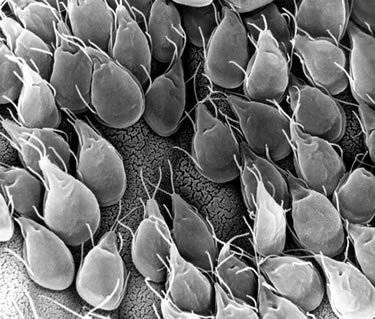
Giardia is a common waterborne parasite that impacts human and other vertebrate animals' gastrointestinal tracts. There are many different species of Giardia. They can be found worldwide in pools, lakes, rivers, oceans, and even processed drinking water in both industrialized and developing countries. Long-term exposure to Giardia can cause dehydration and even death in severe cases. Scientists at the Centers for Disease Control and Prevention wanted to find the optimal pH [a measure of how acidic or alkaline a solution is] range in fresh water for Giardia (Giardia lamblia) growth in order to better detect and eliminate this parasite from potable [water of sufficiently high quality that it can be consumed without harm or risk to the body] drinking water. The water samples that were chosen were from a water pumping station near Washington, DC, which had an average pH value of 7.2. The pH range that was tested was from 6.6 to 7.5. The experimental setup is shown below:
| pH values | Number of ml of water | Giardia sample size |
| 6.6 | 20 | 100 |
| 6.7 | 20 | 100 |
| 6.8 | 20 | 100 |
| 6.9 | 20 | 100 |
| 7.0 | 20 | 100 |
| 7.1 | 20 | 100 |
| 7.2 | 20 | 100 |
| 7.3 | 20 | 100 |
| 7.4 | 20 | 100 |
| 7.5 | 20 | 100 |
Questions
Before we discuss the results of this experiment, let's look at how the scientific process was used here and whether this is a strong scientific test.
Directions: In the boxes below, type your answer to the prompt, then click on the Answer" button to check your answer.
1. What is the control in this experiment?
2. What is the manipulated or independent variable in this experiment?
3. In this experiment, what was the responding or dependent variable?
4. In this experiment, how could scientists reduce uncertainty and avoid bias in the resulting data?
The Results
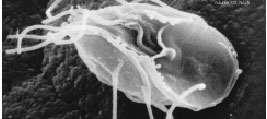
According to this study and background research conducted by the CDC scientists, the optimal pH range for Giardia lambia is between 6.3 and 7.1. Giardia is adapted to live in more acidic environments like the ones found in the intestinal tract. More alkaline environments (above 7.1) are not as conducive for Giardia growth. Therefore, scientists can report that to prevent the growth of Giardia, drinking water should be slightly more alkaline or basic.
Putting it all Together
"The PBS NOVA | Evolution: The Evolutionary Arms Race presents the work of Erika Von Mutius, who studies the relationship between childhood exposure to microbes and the development of asthma and allergies. Here Dr. Von Mutius introduces a hypothesis. Read the video transcript below as you try to determine the scientific process, taking note of the observations that lead to determining a question. In addition, identify the hypothesis that Mrs. Von Mutius proposes, the tests conducted to find an answer, and the conclusions that are made about the experiment.
Evolution: "The Evolutionary Arms Race" Video Transcript
Click each question number or use the next arrow.
1. What is the goal of Erika Von Mutius experiment?
A. To describe the types of microbes found in livestock
B. To determine the environmental exposure of each child to microbes and dust samples
C. To cure all allergies and asthma related illnesses
D. To eradicate microbes from human systems
2. What is the question Erika Von Mutius is asking?
A. Which environmental factors protect children in the Bovarian countryside?
B. Are all microbes bad?
C. Do livestock produce too many microbes and dust?
D. How does our immune system work?
3. What are the preliminary results of Ms.Von Mutius's experiments?
A. Microbes are increasing in rural areas at a higher rate than urban areas.
B. Allergies are on the rise in all children ages 6-12.
C. Earlier and more frequent contact with livestock reduces the development of allergies.
D. Earlier and more frequent contact with livestock increases the development of allergies.
4. How are the tests by Ms. Von Mutius being conducted?
A. By formal and informal questionnaires
B. By collecting dust and other airborne microbes
C. By looking at data from other scientists in the medical field
D. By questioning families and collecting dust samples at the children's homes
5. What conclusion has Ms. Von Mutius and others come to with regards to microbes?
A. A balance must be achieved between harmful and helpful microbes in our lives.
B. It is a big mistake for humans to separate themselves from so many other animals.
C. By looking at data from other scientists in the medical field
D. Microorganisms are increasing in number as more children are getting sick.
6. What is Erika Von Mutius hypothesis in this experiment?
A. Children living in the Bovarian countryside are more exposed to microbes than those in the city.
B. Allergies and asthma may be connected to the lack of exposure to microbes.
C. Many microbes are important for properly functioning immune system responses particularly in youth.
D. All of these.
Text Version
© KC Distance Learning. All rights reserved. Updated 2020-2021 by DVHS.




